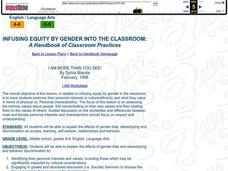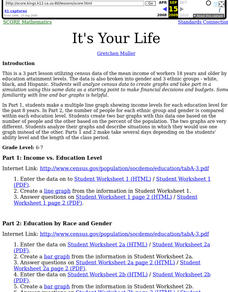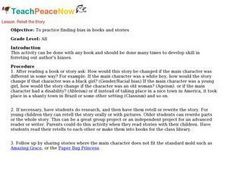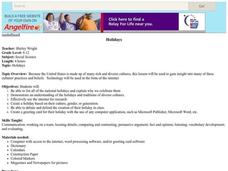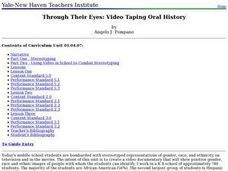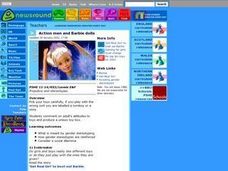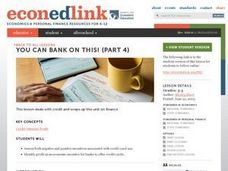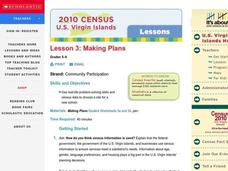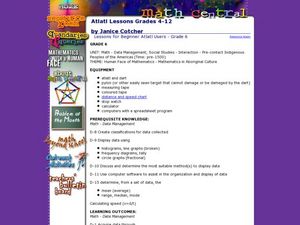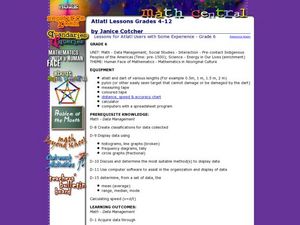Curated OER
All's Fair in Sport And Competition
Students design a physical activity contest or game that has no cultural or gender biases which includes an assessment that ranks competitors according to the competitors abilities. They participate in and evaluate the newly designed...
Curated OER
Balanced Meal Planner
Students use an online website to select foods and put them onto a plate to see if they have made healthy and balanced meals. In this healthy meals lesson plan, students review the food pyramid before this activity.
Curated OER
I Am More Than You See
Students discuss the effects of gender bias and stereotyping by identifying personal interests and values. In this sociology lesson, students iscuss the forces in society which cause gender discrimination, create poems about themselves,...
Curated OER
It's Your Life
Students make a multiple line graph showing income levels for each education level for the past 8 years and the number of people for each ethnic group and gender is compared within each education level.
Curated OER
How Are We Different?
Students discuss the differences between boys and girls. In this acceptance instructional activity, students view pictures of boys and girls and use a Venn Diagram to chart their differences. Students discuss boy activities...
Curated OER
Retell the Story
Learners identify bias in books. For this character education lesson, students read a text and discuss any gender or racial bias which may be present. Learners retell and rewrite the story in a fair way.
Curated OER
Inferring Height From Bone Length
Young scholars determine the relationship between bone length and height. In groups, they are told the race and gender of the individual and discuss how this affects height. They measure the lengths of the bones in metric measurements...
Curated OER
Holidays
Learners make a list of all of the national holidays and explain why we celebrate them. They create a holiday based on their culture, gender, or generation and then debate and defend the creation of their holiday in class. They create...
Curated OER
AFRICAN-AMERICAN HOMESTEADERS
Middle schoolers analyze the factors that inhibited and fostered African American attempts to improve their lives during Reconstruction, the role of class, race, gender, and religion in western communities, and the challenges diverse...
Curated OER
Through Their Eyes: Video Taping Oral History
Students identify the stereotypes they are faced with on a daily basis. In groups, they use this information to identify the ways stereotypes are portrayed in movies and television. They use a video camera to record oral histories of...
Alabama Learning Exchange
The Five Senses: How They Relate to our World
Students explore the five senses and the significance of each sense. In this five senses and diversity lesson, students listen to You Can't Smell a Flower With Your Ear by Joanna Cole and take a walk observing opportunities to use all...
Curated OER
Christmas Shopping
Young scholars pretend to buy age/gender appropriate Christmas presents using a given budget for a specified number of people.
Curated OER
Action Men And Barbie Dolls
Students read and discuss an article about gender sterotyping and adult attitudes about "boy" and "girl" toys. Then they create a unisex toy box for a family friend who is expecting a baby. They give one toy for each of the first 10...
Curated OER
Exploring Women's History
Students read and analyze Jessie Benton Fremont's travelogue of her trip out west in 1849 to identify the gender roles, social attitudes and class distinctions of the time. They then adapt the the travelogue into a film script.
Curated OER
Diversity Stereotyping
Students discuss the concept of stereotyping and using "diversity beans" process an activity that allows them to examine the negative aspects of strereotyping through candy.
Council for Economic Education
You Can BANK on This! (Part 4)
Students assess both negative and positive incentives associated with credit card use. They identify profit as an economic incentive for banks to offer credit cards.
Curated OER
Hinges I, Hinges II
Students use their bodies in daily activities, by promoting a regular routine of using large and small motor skills, personal space, and boundary awareness. They move a scarf to the rhythm of the different kinds of music the teacher...
Curated OER
Making Plans
Students gain an understanding of the U.S. Census. In this civic lesson plan, students use real-life problem-solving skills and census data to choose a site for new school.
Curated OER
Grammatical Person: 1st, 2nd, and 3rd Person
In this grammatical person: first, second, and third person worksheet, students determine the speaker/participants relationship. Students use a chart to identify grammatical person in seventeen sentences.
Curated OER
Something From Nothing
Students listen to story Joseph Had A Little Overcoat to explore people from another culture and how one item can be used to make other items; students use scraps of fabric and other knickknacks to create pictures or toys.
Curated OER
Communication
Students identify methods of conflict resolution as related to marriage. They discover some ideas about how to say "No" and evaluate their own communication patterns for roadblocks they may be using. They study good couple...
Curated OER
Atlatl Lessons Grades 4-12: Lesson for Beginning Users of Atlatl
Sixth graders determine the mean, range median and mode of a set of numbers and display them. In this data instructional activity students form a set of data and use computer spreadsheet to display the information. They extend of...
Curated OER
Lessons for Atlatl Users with Some Experience-Grade 5
Fifth graders throw darts, collecting data for distance traveled. In this data analysis lesson, 5th graders throw a dart using an atlatl. They calculate the speed for each throw and determine the best dart length for distance throws.
Curated OER
Lessons for Atlatl Users with Some Experience-Grade 6
Sixth graders experiment with an atlatl and dart. In this sixth grade data management mathematics lesson plan, 6th graders explore and determine the most suitable methods of displaying data collected from their experimentation with...


